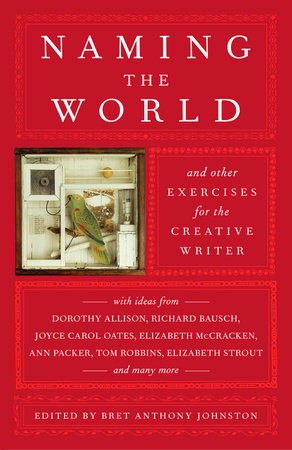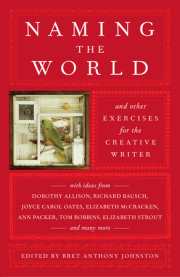John Dufresne
GERMS
Here are some germs, seeds, viruses for your writing. They come in different forms. You’ll think of more. Get used to starting with something small and exact, not with anything as large and as vague as an idea.
THE EXERCISES
1.Start with a line. I’ll give you one. You can find them everywhere in what you read, in what you hear. Find them in poems, newspaper stories, on billboards, in the conversation of the people behind you at the supermarket checkout. Take the line as the opening of your novel. Write it out and keep going. Let it take you where it will. Write for ten minutes or until you want to stop. The line will likely be gone when you revise the piece, if you do. Maybe it will become the epigraph for your novel.
Here’s one line: “Most things will never happen; this one will.” Taken (with grammatical liberties) from Philip Larkin.
Here’s another: “Last night the moon seemed to say something.” (From Frank O’Hara.) One thing I hope these lines do is pull you out of your world and plop you into an imagined one.
2.Start with a list. Your novel begins with a list. Who’s making it? Why? What does it reveal about the list maker?
Here’s the heading for one: “Things That Make One’s Heart Beat Faster.”
And another: “People Who Seem to Suffer.”
(And read The Pillow-Book of Sei Shonagon, from which these lists were taken.)
3.Start with a title. Why not? What does the title suggest to you? Certain themes, perhaps. Characters. A place? Titles are always important. They can be symbolic, can suggest tone, characterize, can push you along. The title is the essence of the novel—which is why, despite our exercise, the title often comes last. Here are a few titles. Do them one at a time. Write and then think.
The Heart Specialist
Murder Your Darlings
You Belong to Me, I Believe
Stirred, Not Shaken
4.Start with a character. Many stories (most of mine) begin with a character.
Here’s one from the unfortunate news of the day: your character is a parish priest who hears the confession of his colleague and fellow curate at St. Paul’s Church and learns that his trusted companion has molested a child.
Here’s another: a mother whose child has been abducted. A chance to deal with our greatest fears, certainly.
5.Start with a situation. The situation should be odd and perhaps a bit troubling. It should make you wonder. Here’s an intriguing situation; make it the opening of your novel or perhaps the end of chapter 1: a landscape architect cries in a restaurant while dining alone. And: a stand-up comic (you’ll have to write jokes!) listens to the neighbors in the next apartment as they fight.
6.Start with an event.
A high school prom
A death in the family
The birth of triplets
A frightening diagnosis
7.Start with an image.
The smell of clothes drying on a line
The sight of salt-crusted work boots tucked under a radiator
The taste of Play-Doh
The sound of fingernails being scraped along a chalkboard
How it feels on your skin when a cloud passes before the sun
8.Start with a subject.
Happy puppet syndrome (a neurological disorder)
High school
Mountain climbing
A drought
9.Start with an oddity.
For instance: a neurology professor (say, at the University of Florida) takes home body parts and stores them in his freezer.
Or try this: The poet Hart Crane committed suicide by leaping from an ocean liner into the sea. His father, Clarence, invented the Life Saver candy in Cleveland. Crane’s Peppermint Life Saver. Since we’re speaking of Cranes, Anton Chekhov had a pet crane in Yalta, a raggedy, one-legged creature that followed Chekhov around. (Was it named Heart, do you suppose?)
Joyce Carol Oates
WRITING PROMPTS
In my princeton fiction workshops i define my role, or one of my roles, as that of an ideal editor: not a rejecting editor, not a censorious or severely critical or interfering editor, but one who defines herself primarily as a friend of the text and a friend of the writer, in that order.
THE EXERCISES
Here are some prompts to start stories:
“An unsolved mystery is a thorn in the heart.” This is the opening line of a short prose piece you are to write, meditating upon an “unsolved mystery” in your own life. You may wish to transpose this into purely fictional terms.
As minutely as possible, you will describe a significant place, conveying by means of language the emotion generated by this place in your imagination.
You will “interview” an older relative, asking questions, eliciting answers, and then, in presenting the speaker’s voice, removing yourself entirely from the text.
A miniature narrative, consisting of a single, very supple sentence.
Christopher Castellani
NOTHING BUT THE TRUTH
At most readings i give from my two novels, someone—usually a man—asks, “So, how come you don’t just write nonfiction?”
Let’s deconstruct this question for a moment.
First, there is the intimacy suggested by the “so,” as if he and I are old friends. I have just read to him from a novel set either in an Italian-American neighborhood in the 1950s or an isolated mountain village in central Italy during World War II. As a thirty-something author who (reportedly) can pass for twenty-six (on a good day), I am obviously not writing from personal experience. The novels tell stories inspired by my parents’ lives, not mine. I choose to take the questioner’s tone—and the question overall—as a compliment: he’s telling me I’ve created a convincing fictional world. He believes he was there strongly enough to request that I confirm that there actually exists.
Next: “How come?” Not “why,” which would be too formal, too scholarly. We are in not a university lecture hall but a community bookstore, surrounded by frothing baristas and beefcake calendars and the homeless. The mood is casual, collaborative. I’m a novelist, therefore an accessible storyteller who’s assembled a group to entertain. (I don’t mind this one bit, by the way; it’s a great joy and honor.) What I find interesting is that most readers view the novel form (and fiction in general) as both common and mystical. Fiction belongs to the people, like IKEA art, and yet fiction writers still invariably inspire respectful awe from those who can’t fathom shaping their riotous imaginations into a sustained plot of interconnected story lines. The questioner might have asked me, “How come you’re such a genius?” Or, at least, “How’d you get so lucky to publish your stuff?”
The next and most important word: just. Despite the fact that nonfiction outsells fiction, and that a book gains instant credibility and increased interest when the phrase “based on a true story” is slapped across the jacket, there is an enduring (mis)perception that nonfiction writers are “just” note takers or recorders of information rather than artisans. Some readers think, “If I had time and a stack of index cards, I, too, could write nonfiction.” And so when they meet someone like me, who is blessed with a rich and colorful family history spanning two continents, they ask, in so many words, “Why’d you bother inventing stories when they can basically write themselves?”
The truth is that nonfiction (a broad genre, of course, but in this case, the questioner and I really mean the memoir or personal essay) is incredibly difficult to write. Moreover, its authenticity is virtually impossible to certify. Truth, after all, is more elusive and less flexible than the imagination; the details and complexities of our experiences vanish as we live them; and, obviously but most importantly, our understanding of these experiences is purely subjective. The memoir or personal essay writer is heavily constricted by such realities, and it is within those restrictions that she shows her remarkable talent: to re-create lived experience using the techniques of fiction (dialogue, description, point of view, scene) while staying uncompromisingly true to “what really happened.” It’s somewhat analogous to a poet choosing to write a pantoum rather than in free verse. The best nonfiction writers are exquisite storytellers and expert craftsmen; they turn the inescapability and inevitably of reality into the most thrilling and satisfying of tales.
That’s the long answer to why I don’t write nonfiction. The short (and guilty) answer might be: It’s incredibly hard. Your plots, settings, and “characters”—yourself included—are too limited. You can’t “just” do a ton of research and hold interviews and make outlines; you must have the human insight of a great novelist with double the vigilance and discipline in your analysis.
Copyright © 2008 by Bret Anthony Johnston. All rights reserved. No part of this excerpt may be reproduced or reprinted without permission in writing from the publisher.








